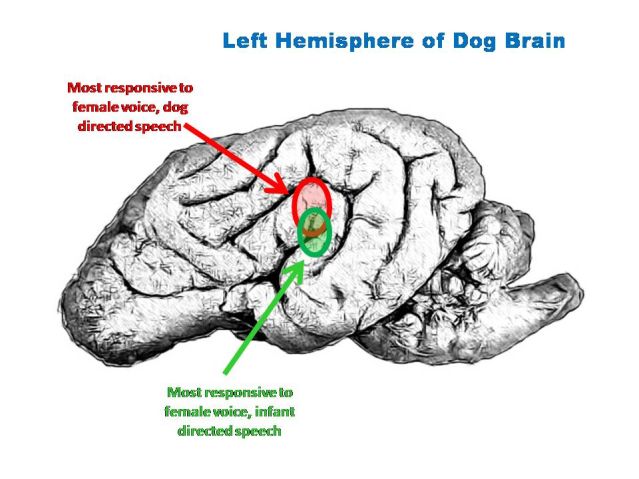Animal Behavior
Why Dogs Listen More Closely to Female Voices
Style of speech matters as well; try "Doggerel."
Posted August 25, 2023 Reviewed by Devon Frye
Key points
- People use different forms of speech when speaking to infants and dogs, called "Motherese" and "Doggerel."
- Research has shown that a child's brain responds more vigorously when listening to infant-directed speech.
- Recent fMRI data shows that a dog's brain is more responsive to dog-directed speech spoken by women.
- This special tuning of the dog's brain may explain why women might be more effective dog trainers.

When I walked into the room I heard a woman speaking to someone. She was saying “You are so adorable! Yes, you are! You are. You are so sweet that you make sugar seem sour. Don't you? Don't you?” She had pitched her voice quite high and was delivering the words in a melodious singsong rhythm.
Before I even turned to look at her, I knew that she was speaking to either a baby or a dog. When I did look in her direction, I saw that she was holding a cream-coloured Pomeranian to whom this outpouring of affection was directed. So natural is this impulse to change one’s voice and speech patterns when addressing babies, puppies, or dogs that she probably didn't even realize that her speech patterns had veered from "normal."
Talking to Dogs and Babies
We all know that our language changes under different circumstances. For example, there is a formal language that we utilize when we are giving a speech to an audience or talking to authorities. It is more reserved and ceremonial than the language that we employ when we are talking with family and friends.
Similarly, there is a special kind of language that we use when we are talking to babies and very young children. When talking to babies we tend to use a higher-pitched, almost musical tone, with lots of changes in harmony, and with many repetitions. Technically, this form of verbal communication should be called "infant-directed speech"; however, researchers typically call this special language reserved for children "Motherese." The name comes from the fact that it is usually the language that mothers use when they are talking to their offspring, even though individuals who are not mothers tend to use the same tones when talking to very young children.
Back in the 1980s, psychologists Kathy Hirsh-Pasek and Rebecca Treiman (then at the University of Pennsylvania) were able to show that the language that we use when we are talking to dogs is very similar to Motherese. Technically it should be called "dog-directed speech"; instead, however, they playfully labeled this form of language "Doggerel."
Over the years, additional research has shown that both children and dogs actually do pay more attention when they are spoken to in Motherese or Doggerel. Recent studies have even shown that the brains of our children actually respond more vigorously to Motherese. These findings raise the question as to whether dog brains are similarly sensitive to the way that we speak to them.
Brains Tuned to Listen
To answer this question Anna Gergely and a team of investigators at Eötvös Loránd University in Budapest, Hungary, used fMRI (functional magnetic resonance imaging) to measure the brain activity of 19 family dogs as they listened to speech directed at dogs, infants, and adults. Each speech sample contained full sentences recorded by both female and male speakers who were unfamiliar to the dogs. The speech stimuli came from adult speakers who were engaging in normal positive interactions with their own babies, family dogs, or another adult.
The data revealed that there were regions in the left side of the dog's brain, slightly to the front of the normal auditory response regions, which are special. These brain areas responded more to dog- and infant-directed speech than to normal adult-directed speech. So this is neural evidence showing that dog's brains, just like the brains of human children, are attuned to exactly the kind of special speech patterns that people usually direct to them. Dogs appear to be particularly sensitive to both dog-directed speech and infant-directed speech.

Of particular interest was the fact that these areas of the canine brain were most sensitive and responsive to female voices, especially when the women were speaking Doggerel or Motherese. This may explain an ongoing puzzle about the effectiveness of dog training.
Are Women Better Dog Trainers?
Many people have noticed that, when it comes to dog trainers who work with companion dogs, the overwhelming majority seem to be women. This is not the case when it comes to those who train field dogs or protection dogs. In those areas, the majority of trainers seem to be men. It has often been argued that these areas have a majority of male trainers because field dogs are associated with guns and hunting, which are less interesting to women, and protection dogs are associated with more "macho" and confrontational settings which women may have a propensity to shy away from.
The degree to which women tend to dominate the companion dog training and obedience competition field is quite amazing. According to some data that I collected, four out of five companion dog trainers are women.
As an informal example, I contacted some friends in several different cities in North America. I asked them to simply count the number of people at the next dog behavior seminar or workshop that they attended, and to break it down by the number of men and women. I ended up with a count of 311 attendees, of whom 261 were women. That means that 84 percent of the people attending these events (which were designed for trainers who want to improve the performance of competitive dogs) were female.
Furthermore, the women trainers seem to be quite good at what they are doing. Take the results of the year 2022 in dog obedience competitions sponsored by the Canadian Kennel Club. All of the top 10 obedience dogs for this year had female handlers. The probability of this happening by chance alone is less than 0.001 (one in a thousand).
This new brain scan data suggests that the reason that women may be better trainers might not come exclusively from them being, perhaps, kinder or more perceptive teachers, but also from the fact that the brains of dogs are more sensitively tuned to the female voice, especially when it is using dog-directed speech or Doggerel.
Copyright SC Psychological Enterprises Ltd. May not be reprinted or reposted without permission.
Facebook image: Maliutina Anna/Shutterstock
References
Gergely A, Gábor A, Gácsi M, Kis A, Czeibert K, Topál J, Andics A. (2023). Dog brains are sensitive to infant- and dog-directed prosody. Communications Biology 6, 859. https://doi.org/10.1038/s42003-023-05217-y
Coren, S. (2016). Are Women Better Dog Trainers Than Men? Psychology Today, Canine Corner, https://www.psychologytoday.com/blog/canine-corner/201601/are-women-better-dog-trainers-men




